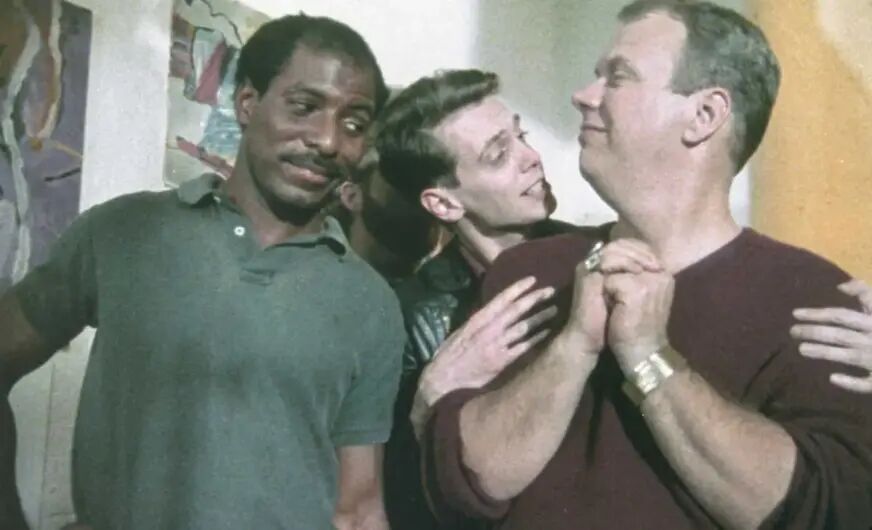
Welcome back to our queer film retrospective, “A Gay Old Time.” In this week’s column, we’re revisiting 1986’s Parting Glances, an indie dramedy and one of the first film’s to address the AIDS epidemic.
This January marks the 40th anniversary of the Sundance Film Festival. Founded by actor Robert Redford as an attempt to elevate and highlight independent voices in film, the festival has become one of the most important cultivators of new filmmaking talent, as countless directors, writers, and other talent have gotten their start in the snowy Utah mountains.
Ever since its inception, programming by and about queer people has been an essential part of the festival; films like Desert Hearts (1986), Paris Is Burning (1991), Boys Don’t Cry (1999), Hedwig And The Angry Inch (2001) and Call Me By Your Name (2017) all got their jumpstart in Park City.
Your dose of fabulosi-TEA
Subscribe to our newsletter for your front-row seat to all things entertainment with a sprinkle of everything else queer.
This week, we’re looking back at one of the queer films that premiered at the festival in 1986, the comedic drama Parting Glances; a heartfelt and unwavering look at the 1980s gay scene in New York, when AIDS was making its way through the community, and the community was unwilling to give into it.
The Set-Up
Parting Glances follows Michael (Richard Ganoung) and Robert (John Bolger), a gay couple living in New York City, over the course of the last evening before Robert leaves for a work trip to Africa for two years.
In the twenty four hours that the movie tracks, Michael and Robert journey through a goodbye party thrown by their friend Joan (Kathy Kinney), and a dinner with Robert’s boss Cecil (Patrick Tull) and his wife Betty (Yolande Bavan), who seem to be living in a lavender marriage, as Michael stops by to look afterr his ex-boyfriend Nick (Steve Buscemi in one of his most subtle and yet daring performances), a young musician living with AIDS.
There is very little plot or narrative stakes in the film; the main tension relies on the character’s relationships, dynamics, and emotional bonds with each other. Michael and Robert are clearly going through a rough patch in their relationship; Michael is unclear and uncertain about their future as a couple once Robert goes away for such a long time, while Robert is mostly ignoring or burying his feelings and worries.
There is still a clear and latent emotional bond between Michael and Nick—which Nick seems to encourage, Michael resists, and Robert resents. And there is of course the unnamed but overwhelming sense of loss, grief, and communal bonding that tied them (and all of their friends) together during this period of time.
Parting Glances is helmed by first-time director Bill Sherwood, who himself died of AIDS complications only a few years after in 1990. It feels like an incredibly personal story, and in many ways more as an act of preservation (of himself, of his friends, of his community) rather than a purely filmmaking effort.
The Buscemi Factor

Although not the protagonist, Steve Buscemi’s Nick stands out as the most fascinating and (ironically in many ways) alive of the characters. His disease and condition is never dwelled on or painfully dissected, but it has clearly affected how he moves about his life. There is a sense of reckless abandon in how openly he talks and acts upon his feelings, and a very tricky balance of joyous freedom and bitterness that AIDS seems to have given him.
Buscemi, in one of his earliest roles, has never quite played a character so open and charming before or since, and embodies Nick’s vulnerability and cynicism in equal measure. He is also an interesting contrast to both Michael and Robert, who are so tied inside their own relationship dynamics that appear sometimes shielded from the rest of the world.
The Way We Were

Parting Glances joins a list of movies we have covered in this column that choose to portray the queer community (often during or at the corners of the AIDS crisis) in an almost naturalistic way: films like Sticks And Stones (1970), A Very Natural Thing (1974) and Some Of My Best Friends Are (1971) all have a very compact narratives that focus more on character dynamics and relationships rather than plot beats or complications.
All choose to portray the lives of their (mostly) gay men protagonists as mundane, non-extraordinary, and heavily centered on friendships and romances that are in essence true, thorny, and deep. All of these, including Parting Glances, seem more preoccupied with capturing the world as it was for the people that made them than dramatizing, heightening, or criticizing it.
This is a very defined shift from a lot of queer filmmaking that would come after it starting in the 1990s, and that is even less common now. This examination probably deserves its own piece for a fuller and more nuanced dive. But with almost thirty years removed from the film and countless ways in which gay life has changed from the one portrayed, it is still moving to see the honesty, matter-of-factness and lack of judgment that Parting Glances showcases.
One Last Glance
The film seems to be part of an unofficial filmmaking movement that preceded the much more radical and experimental New Queer Cinema wave of the 1990s (a movement that also found its footing at the Sundance Film Festival). One where filmmakers took the reigns of queer storytelling and decided to point the cameras at themselves, their friends, and their community. At a time when the world was spewing narratives and stereotypes about us and our lifestyles, queer filmmakers chose to showcase how their world actually was.
There is a lot of heart, emotion, and fun in Parting Glances. It is an unpretentious movie with complex characters, strong performances and an even stronger point of view: a point of view that dares to show a community in the midst of a plague, but won’t make that the center. It instead focuses on the relationships, romance, and smaller things that made life worth continuing.
Parting Glances is available to stream on Fandor, Flix, Kanopy, Ovid, Tubi, and Plex.
Related:
Murderous mean girls, toxic relationships & more classic queer Sundance picks to stream this weekend
Check out these LGBTQ+ streaming picks that premiered or screened at the iconic film fest over the years…



















HalcyonDays
I’m guessing whoever wrote this piece was not around during the height of the AIDS epidemic of the 1980s and early 1990s.
It’s a wonderful film, but I don’t think any of us who sat in the theater during the original release would describe it as a “comedic drama” or a “charming slice-of-life.” While the film has wit and charm, I wouldn’t lead with those adjectives. They minimize the emotional depth of the film. It was truly revolutionary for it’s time.
wikidBSTN
Well said – spot on.
gjg64
That was the first “gay” movie I saw when it came out and I was newly out myself. It was so moving. I consider it a classic.
KissBananaPeels
YES it is a classic and it is deserving of that honor. I re-watch as often as possible…
it is on TubiTV where you can watch it for FREE…
bachy
I remember this film from the 80s, and how powerful it was. But am I alone in having difficulty revisiting films about the AIDS crisis? I lost so many dear friends and wept so many tears, that I can’t look back anymore – only forward.
wikidBSTN
It is difficult to think back to those times, but while AIDS plays a part, the story is more about the nature of friendships and relationships for gay people. It is still very relevant today.
wikidBSTN
I saw this movie on Cinemax when I was 21 – and it was the reason for my coming-out. I had never met an out gay person before and I had never seen gays or a gay relationship portrayed in such a “normal” setting. I felt I could identify with these characters to some meaningful degree.
I love this movie – I own the DVD – and every now and then I re-watch it. It brings me back to my youth, the 80’s and my decision to come out – all good things.
Huron132
Parting Gances is one of my all time favorites. I remember when it first started showing in theaters. I live in a Midwestern state and it was showing at one of the two advantgarde theaters that showed art house and gay/gay leaning movies. I was so proud and happy I got to see this movie and I still am. We don’t have those types of theaters any more they show the latest movies that come out now. I miss having those theaters now and the movies they showed.
dbmcvey
Parting Glances is a great film! One of my all-time favorites. It is so true to the time.
barryaksarben
GREAT MOVIE ALL AROUND. the friendships ring true and the loves. Funny we dont see all our trolls like. our dear sweet baron or where are the other screen names he uses? they all swear they are gay and that you cant get gay men to agree to anything. but.here is a movie we all love and they are no where to be seen. tell us again how the right are our real friends and. name the real gay movies that prove it and how this is a lie and how it pushes an anti gay agenda. Just think of all the screen names that are missing from this and any other very positive gay stories and that includes about women and poc and trans. the very mention of trans made the hair on my neck rise just knowing they must have notice. on their screens that trans was mentioned so they better get on here asap to push their hatred on us yet again. Oh Dear Baron wtf dude where are you? and your teeny tiny penis